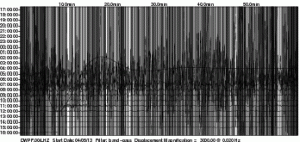
A seismograph reading showing an increase in earthquake activity.
The Southern Hemisphere was very active with large earthquakes and volcanic rumbles on July 7, 2013.
By mapping the locations of these quakes, you can see increased wobbling at the Earth’s poles; you can see the climb in earthquake intensity, and you can also see how the magnitudes of these quakes have been lowered a bit.
Two Tips For Watching Quakes
Here are two, basic tips to watch for when you read about global earthquakes:
- watch the magnitudes go up or down
- look for a pattern in quake locations
I really don’t think the magnitudes that are logged in the record books are completely accurate despite the millions of dollars USGS invests in equipment. If you look closely on their website, you’ll see how many quakes are recorded at 2.9, 3.9, 4.9, 5.9, 6.9, 7.9 and so on …..
Filling Up At The Pump

Earthquake magnitudes are like gas prices – they record them just a little under their real readings to make you think they are a little lower than what they really are.
It slays me to see gas prices go up and down for no logical reason, but what really gets me is how the prices are posted in ways to make you think the prices are a little lower than they are.
Advertisers do this for just about anything you buy – $9.99 or $49.99 – why not just call a duck a duck and label the things accurately … it’s not $9.99, it’s $10 bucks + tax.
Well, it seems USGS does this, too, by lowering the magnitudes of earthquakes to just below a measurement that shows the increase in earthquakes today.
EQs July 7, 2013
Out of 134 quakes that occurred on July 7, 2013, 57 quakes were above 4.5, but 19 were logged as a .9, and 10 were recorded as a .8. This may be no big deal, but when it comes to accuracy, I want my data true data, especially when it focuses on the LARGER earthquakes. So, for the list below, I’d at least bump the .9 quakes up 1/10 of a point.
Here’s the July 7, 2013 list of large quakes in the Southern Hemisphere in order of occurrance, and look at these point patterns:
- 7.3 Solomon Islands (lowered to 7.2)
- 6.6 Kandrian, New Guinea
- 4.8 New Zealand
- 5.8 Pujiharjo, Indonesia
- 5.9 El Rosario, El Salvador
- 4.7 Visokoi Island off Argentina
- 4.9 Barbuda
Does It Really Matter?
Do the magnitudes really matter if they are off by a 1/10 of a point or so? Yes and no. The system is merely a human interpretation, anyway. Magnitude scales may be way off and we just haven’t considered changing it. But, if an earthquakes is really a 5.0 magnitude, I’d like to know that as opposed to seeing it recorded as at 4.9.
In the long-run, THIS does make a difference, especially with larger quakes.
